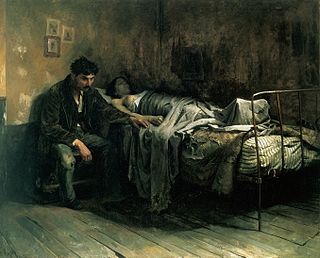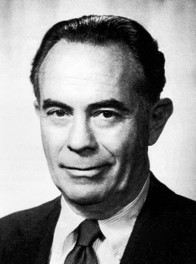
Emil von Behring, born Emil Adolf Behring, was a German physiologist who received the 1901 Nobel Prize in Physiology or Medicine, the first one awarded in that field, for his discovery of a diphtheria antitoxin. He was widely known as a "saviour of children," as diphtheria used to be a major cause of child death. He was honored with Prussian nobility in 1901, henceforth being known by the surname "von Behring."

Bloodletting is the withdrawal of blood from a patient to prevent or cure illness and disease. Bloodletting, whether by a physician or by leeches, was based on an ancient system of medicine in which blood and other bodily fluids were regarded as "humours" that had to remain in proper balance to maintain health. It is claimed to have been the most common medical practice performed by surgeons from antiquity until the late 19th century, a span of over 2,000 years. In Europe the practice continued to be relatively common until the end of the 18th century. The practice has now been abandoned by modern-style medicine for all except a few very specific medical conditions. It is conceivable that historically, in the absence of other treatments for hypertension, bloodletting sometimes had a beneficial effect in temporarily reducing blood pressure by reducing blood volume. However, since hypertension is very often asymptomatic and thus undiagnosable without modern methods, this effect was unintentional. In the overwhelming majority of cases, the historical use of bloodletting was harmful to patients.

The disease mycobacterial cervical lymphadenitis, also known as scrofula and historically as king's evil, involves a lymphadenitis of the cervical lymph nodes associated with tuberculosis as well as nontuberculous (atypical) mycobacteria.

The Pasteur Institute is a French non-profit private foundation dedicated to the study of biology, micro-organisms, diseases, and vaccines. It is named after Louis Pasteur, who made some of the greatest breakthroughs in modern medicine at the time, including pasteurization and vaccines for anthrax and rabies. The institute was founded on June 4, 1887, and inaugurated on November 14, 1888.

A sanatorium is a medical facility for long-term illness, most typically associated with the treatment of tuberculosis (TB) in the late-nineteenth and early-twentieth century before the discovery of antibiotics. A distinction is sometimes made between "sanitarium" or the east-European "sanatorium" and "sanatorium".

Tuberculin, also known as purified protein derivative, is a combination of proteins that are used in the diagnosis of tuberculosis. This use is referred to as the tuberculin skin test and is recommended only for those at high risk. Injection is done into the skin. After 48 to 72 hours if there is more than a five to ten millimeter area of swelling the test is considered positive.

Edward Livingston Trudeau was an American physician who established the Adirondack Cottage Sanitarium at Saranac Lake for treatment of tuberculosis. Dr. Trudeau also established the Saranac Laboratory for the Study of Tuberculosis, the first laboratory in the United States dedicated to the study of tuberculosis. He was a public health pioneer who helped to establish principles for disease prevention and control.

Dr. Ehrlich's Magic Bullet is a 1940 American biographical film directed by William Dieterle and starring Edward G. Robinson, based on the true story of the German doctor and scientist Dr. Paul Ehrlich. The film was released by Warner Bros., with some controversy considering the subject of syphilis in a major studio release. It was nominated for an Oscar for its original screenplay, but lost to The Great McGinty.

The Trudeau Institute is an independent, not-for-profit, biomedical research center located on a 42 acres (170,000 m2) campus in Saranac Lake, New York. Its scientific mission is to make breakthrough discoveries that lead to improved human health.

Between 1873 and 1945, Saranac Lake, New York became a world-renowned center for the treatment of tuberculosis, using a treatment that involved exposing patients to as much fresh air as possible under conditions of complete bed-rest. In the process, a specific building type, the "Cure Cottage", developed, built by residents seeking to capitalize on the town's fame, by physicians, and often by the patients themselves. Many of these structures are extant, and their historic value has been recognized by listing on The National Register of Historic Places.

The Adirondack Cottage Sanitarium was a tuberculosis sanatorium established in Saranac Lake, New York in 1885 by Dr. Edward Livingston Trudeau. After Trudeau's death in 1915, the institution's name was changed to the Trudeau Sanatorium, following changes in conventional usage. It was listed under the latter name on the National Register of Historic Places in 1995.

Throughout history, the disease tuberculosis has been variously known as consumption, phthisis and the White Plague. It is generally accepted that the causative agent, Mycobacterium tuberculosis originated from other, more primitive organisms of the same genus Mycobacterium. In 2014, results of a new DNA study of a tuberculosis genome reconstructed from remains in southern Peru suggest that human tuberculosis is less than 6,000 years old. Even if researchers theorise that humans first acquired it in Africa about 5,000 years ago, there is evidence that the first tuberculosis infection happened about 9,000 years ago. It spread to other humans along trade routes. It also spread to domesticated animals in Africa, such as goats and cows. Seals and sea lions that bred on African beaches are believed to have acquired the disease and carried it across the Atlantic to South America. Hunters would have been the first humans to contract the disease there.

Friedrich Franz Friedmann was a tuberculosis researcher in Berlin who came to New York City to give what he called the "turtle vaccine" to people who came to his clinic in 1913. He claimed to have developed a strain capable of providing immunity, by passing the strain through turtles.

The Doctor's Dilemma is a 1958 British drama film directed by Anthony Asquith and starring Leslie Caron, Dirk Bogarde, Alastair Sim, and Robert Morley. It is based on the 1906 play The Doctor's Dilemma by George Bernard Shaw. A satire on the pretensions of the medical profession and their concentration on treating patients who can pay well, it contrasts their world of imperfect science, always bumping up against unknowns, with the boundless spheres of love and beauty.

James Gerald Hirsch was an American physician and biomedical researcher who specialized in immunology. Hirsch was also notable for his studies of phagocyte.
George Heath may refer to:
The town of Colorado Springs, Colorado played an important role in the history of tuberculosis in the era before antituberculosis drugs. Tuberculosis management before this era was difficult and often of limited effect. In the 19th century, a movement for tuberculosis treatment in hospital-like facilities called sanatoriums became prominent, especially in Europe and North America. Thus people sought tuberculosis treatment in Colorado Springs because of its dry climate and fresh mountain air. Some people stayed in boarding houses, while others sought the hospital-like facilities of sanatoriums. In the 1880s and 1890s, it is estimated that one-third of the people living in Colorado Springs had tuberculosis. The number of sanatoriums and hospitals increased into the twentieth century. During World War II, medicines were developed that successfully treated tuberculosis and by the late 1940s specialized tuberculosis treatment facilities were no longer needed.
William Cecil Bosanquet was an English physician and classical scholar.
The International Congress on Tuberculosis was a series of major congresses held between 1899 and 1912 in which scientists and physicians exchanged information on tuberculosis, a significant cause of death at the time.

Frederick William Forbes Ross F.R.C.S. was a British surgeon and inventor. Ross was an alternative cancer treatment advocate who promoted the theory that cancer is caused by a deficiency of potassium salts in the body and that if the deficiency is remedied, cancer will retrograde. He also commended the use of raw meat as a treatment for tuberculosis.
















